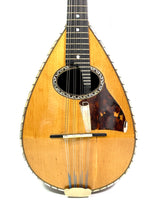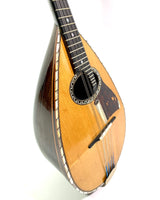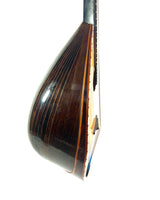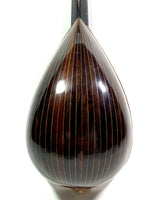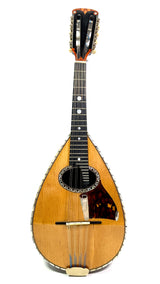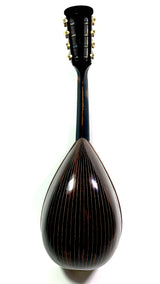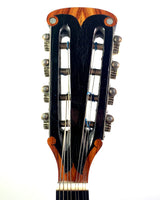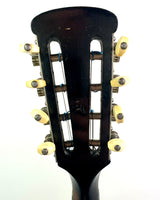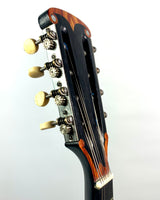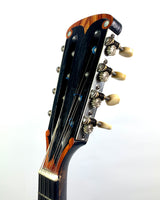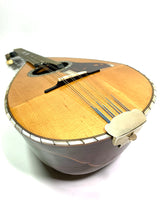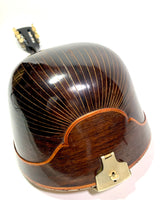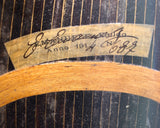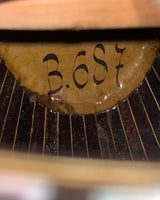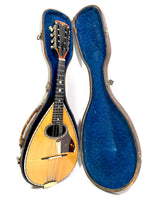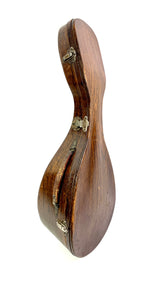Emanuele Egildo
1914 Emanuele Egildo Model B Concert Mandolin
Egildo Emanuele (1866-1955) would have been an Italian disciple of Luigi Embergher, but unlike the latter he would have spent his entire career as a luthier in France from the dawn of the 20th century, with the exception of his supposed apprenticeship at Rome.
Indeed, Emanuele shows throughout his production, from 1899 to the end of the 1940s, an in-depth knowledge of Embergher's instruments as well as the latter's theoretical research. However, if he takes the model of his instruments, he does not copy them slavishly, seeking to develop a more condensed range, between quality requirements and reasonable prices . His hand, nonetheless different from that of Embergher, does not exclude a powerful personality which pierces through all his instruments: mandolins above all, but also bandurrias and guitars.
Its bias is to offer more than Embergher for a lower price, thanks to certain concessions on decorations and finishes, often less precise, but with a superior choice of wood on intermediate instruments and small instruments. It is for this reason that he is rightly nicknamed “the French Embergher”.
Here, this beautiful mandolin from 1914 , bearing the number 687, is a model B (A being reserved for mandolins with Lombard head and C for entry-level to intermediate mandolins), entirely original, signed inside, in its most high-end version : with reinforcements, an interior varnish, an ornate plate, a compensated bridge with a bone nut and a table edged with mother-of-pearl pistagnes, which corresponds to the Embergher model 4.
Certainly made to order for an orchestral soloist, this instrument features a unique headstock veneered with rosewood and inlaid with mother-of-pearl by Emanuele.
This mandolin has 29 ribs of superb rosewood, used by Emanuele for less than 1 instrument out of 15, mostly preferring maple.
The sound is therefore particularly projected and sonorous, in the bass as in the treble, also thanks to a hollowed out key according to the patent of Giovanni Battista Maldura, which Embergher also used successfully for his own mandolins .

Image of the technical drawing of Giovanni Battista Maldura's patent for the fingerboard and bridge from 1884.
(Source: Lorenzo Lippi)
The slot on the table has been restored according to the rules of the art and no longer presents any risk to the structure of the instrument.
Technical characteristics :
- Top: Spruce
- Back: 29 rib rosewood
- Handle: Beech black finish
- Fingerboard: Ebony
- Width at nut: 25 mm
- Radius: Roman Type Maldura
- Frets: 24 frets (+ one zero fret)
- Scale: 344 mm
- Profile: Romain (V)
- Pickguard: Tortoiseshell and white mother-of-pearl
- Country of manufacture: France
- Year: 1914
- Finish: Natural
- Decorations: White mother-of-pearl pistagne on the edge of the table / Rosette inlaid with white mother-of-pearl in the shape of Greek motifs / Circular-shaped white mother-of-pearl key markers / Head inlaid with rosewood and white mother-of-pearl
- Details: Table slot repaired / Very good condition
This mandolin is completely restored and perfectly playable, it has a particularly pleasant playing comfort, with a beautiful original compensated bridge.
The choice was made to mount the instrument with Optima flatwound light strings, manufactured by Lenzner, which offer it a very soft touch and sound, with a powerful sound with good projection, typical of Romans, as well as effortless playability, while preserving this instrument, which is already more than a century old.
Like all our instruments, the mandolin is delivered perfectly tuned and ready to play, with a low action, in its original “mahogany” case, with no further costs incurred.

